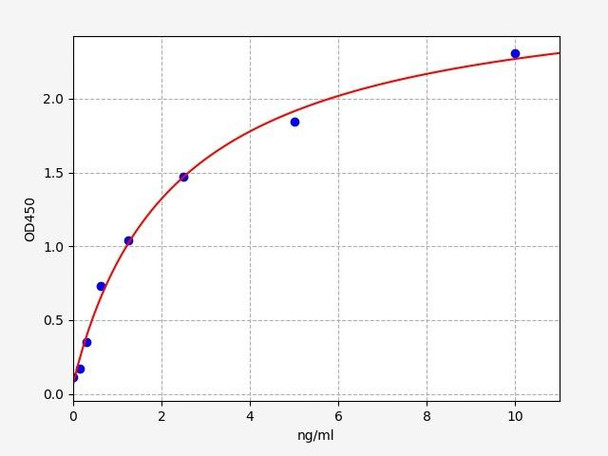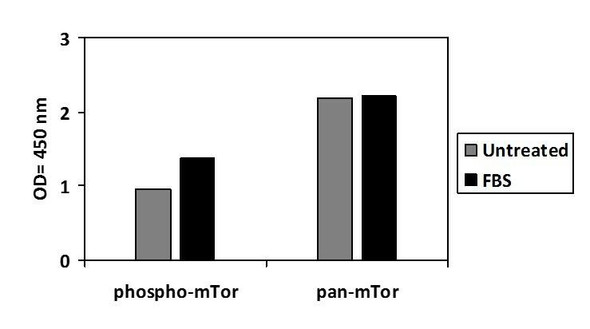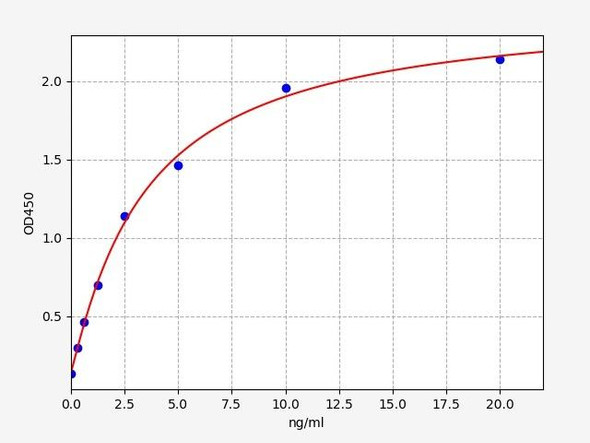Human mTOR ELISA Kit (HUFI01396)
- SKU:
- HUFI01396
- Product Type:
- ELISA Kit
- Size:
- 96 Assays
- Uniprot:
- P42345
- Sensitivity:
- 0.094ng/ml
- Range:
- 0.156-10ng/ml
- ELISA Type:
- Sandwich
- Synonyms:
- MTOR, Serine, threonine-protein kinase mTOR, Rapamycin target protein 1, Rapamycin target protein 1, RAPT1, Mechanistic target of rapamycin, Mammalian target of rapamycin, mTOR, FK506-binding protein 12-rapamycin complex-associated protein 1, FKBP12-
- Reactivity:
- Human
- Research Area:
- Cell Biology
Description
Human mTOR ELISA Kit
mTOR belongs to a family of phosphatidylinositol kinase-related kinases, which mediates cellular responses to stresses such as DNA damage and nutrient deprivation. mTOR controls protein synthesis, cell growth and proliferation, and also acts as a regulator of the actin cytoskeleton. Mutations in mTOR are associated with Smith-Kingsmore syndrome and somatic focal cortical dysplasia type II. Inhibitors of mTOR are used in organ transplants as immunosuppressants, and are being evaluated for their therapeutic potential in SARS-CoV-2 infections.
Key Features
| Save Time | Pre-coated 96 well plate | |
| Quick Start | Kit includes all necessary reagents | |
| Publication Ready | Reproducible and reliable results |
Overview
| Product Name: | Human mTOR ELISA Kit |
| Product Code: | HUFI01396 |
| Size: | 96 Assays |
| Alias: | MTOR, Serine, threonine-protein kinase mTOR, Rapamycin target protein 1, Rapamycin target protein 1, RAPT1, Mechanistic target of rapamycin, Mammalian target of rapamycin, mTOR, FK506-binding protein 12-rapamycin complex-associated protein 1, FKBP12-rapamycin complex-associated protein, FRAP, FRAP1, FRAP2 |
| Detection Method: | Sandwich ELISA, Double Antibody |
| Application: | This immunoassay kit allows for the in vitro quantitative determination of Human MTOR concentrations in serum plasma and other biological fluids. |
| Sensitivity: | 0.094ng/ml |
| Range: | 0.156-10ng/ml |
| Storage: | 4°C for 6 months |
| Note: | For Research Use Only |
Additional Information
| Recovery | Matrices listed below were spiked with certain level of Human MTOR and the recovery rates were calculated by comparing the measured value to the expected amount of Human MTOR in samples.
| ||||||||||||||||||||
| Linearity | The linearity of the kit was assayed by testing samples spiked with appropriate concentration of Human MTOR and their serial dilutions. The results were demonstrated by the percentage of calculated concentration to the expected.
| ||||||||||||||||||||
| CV(%) | Intra-Assay: CV<8% |
Kit Components
| Component | Quantity | Storage |
| ELISA Microplate (Dismountable) | 8x12 strips | 4°C for 6 months |
| Lyophilized Standard | 2 | 4°C/ -20°C |
| Sample/Standard Dlution Buffer | 20ml | 4°C |
| Biotin-labeled Antibody (Concentrated) | 120ul | 4°C (Protection from light) |
| Antibody Dilution Buffer | 10ml | 4°C |
| HRP-Streptavidin Conjugate (SABC) | 120ul | 4°C (Protect from light) |
| SABC Dilution Buffer | 10ml | 4°C |
| TMB Substrate | 10ml | 4°C (Protection from light) |
| Stop Solution | 10ml | 4°C |
| Wash Buffer (25X) | 30ml | 4°C |
| Plate Sealer | 5 | - |
Other materials required:
- Microplate reader with 450 nm wavelength filter
- Multichannel Pipette, Pipette, microcentrifuge tubes and disposable pipette tips
- Incubator
- Deionized or distilled water
- Absorbent paper
- Buffer resevoir
Protein Information
Protocol
*Note: Protocols are specific to each batch/lot. For the exact instructions please follow the protocol included in your kit.
Before adding to wells, equilibrate the SABC working solution and TMB substrate for at least 30 min at 37°C. When diluting samples and reagents, they must be mixed completely and evenly. It is recommended to plot a standard curve for each test.
| Step | Procedure |
| 1. | Set standard, test sample and control (zero) wells on the pre-coated plate respectively, and then, record their positions. It is recommended to measure each standard and sample in duplicate. Wash plate 2 times before adding standard, sample and control (zero) wells! |
| 2. | Aliquot 0.1ml standard solutions into the standard wells. |
| 3. | Add 0.1 ml of Sample / Standard dilution buffer into the control (zero) well. |
| 4. | Add 0.1 ml of properly diluted sample ( Human serum, plasma, tissue homogenates and other biological fluids.) into test sample wells. |
| 5. | Seal the plate with a cover and incubate at 37 °C for 90 min. |
| 6. | Remove the cover and discard the plate content, clap the plate on the absorbent filter papers or other absorbent material. Do NOT let the wells completely dry at any time. Wash plate X2. |
| 7. | Add 0.1 ml of Biotin- detection antibody working solution into the above wells (standard, test sample & zero wells). Add the solution at the bottom of each well without touching the side wall. |
| 8. | Seal the plate with a cover and incubate at 37°C for 60 min. |
| 9. | Remove the cover, and wash plate 3 times with Wash buffer. Let wash buffer rest in wells for 1 min between each wash. |
| 10. | Add 0.1 ml of SABC working solution into each well, cover the plate and incubate at 37°C for 30 min. |
| 11. | Remove the cover and wash plate 5 times with Wash buffer, and each time let the wash buffer stay in the wells for 1-2 min. |
| 12. | Add 90 µl of TMB substrate into each well, cover the plate and incubate at 37°C in dark within 10-20 min. (Note: This incubation time is for reference use only, the optimal time should be determined by end user.) And the shades of blue can be seen in the first 3-4 wells (with most concentrated standard solutions), the other wells show no obvious color. |
| 13. | Add 50 µl of Stop solution into each well and mix thoroughly. The color changes into yellow immediately. |
| 14. | Read the O.D. absorbance at 450 nm in a microplate reader immediately after adding the stop solution. |
Sample Type
When carrying out an ELISA assay it is important to prepare your samples in order to achieve the best possible results. Below we have a list of procedures for the preparation of samples for different sample types.
| Sample Type | Protocol |
| Serum | If using serum separator tubes, allow samples to clot for 30 minutes at room temperature. Centrifuge for 10 minutes at 1,000x g. Collect the serum fraction and assay promptly or aliquot and store the samples at -80°C. Avoid multiple freeze-thaw cycles. If serum separator tubes are not being used, allow samples to clot overnight at 2-8°C. Centrifuge for 10 minutes at 1,000x g. Remove serum and assay promptly or aliquot and store the samples at -80°C. Avoid multiple freeze-thaw cycles. |
| Plasma | Collect plasma using EDTA or heparin as an anticoagulant. Centrifuge samples at 4°C for 15 mins at 1000 × g within 30 mins of collection. Collect the plasma fraction and assay promptly or aliquot and store the samples at -80°C. Avoid multiple freeze-thaw cycles. Note: Over haemolysed samples are not suitable for use with this kit. |
| Urine & Cerebrospinal Fluid | Collect the urine (mid-stream) in a sterile container, centrifuge for 20 mins at 2000-3000 rpm. Remove supernatant and assay immediately. If any precipitation is detected, repeat the centrifugation step. A similar protocol can be used for cerebrospinal fluid. |
| Cell culture supernatant | Collect the cell culture media by pipette, followed by centrifugation at 4°C for 20 mins at 1500 rpm. Collect the clear supernatant and assay immediately. |
| Cell lysates | Solubilize cells in lysis buffer and allow to sit on ice for 30 minutes. Centrifuge tubes at 14,000 x g for 5 minutes to remove insoluble material. Aliquot the supernatant into a new tube and discard the remaining whole cell extract. Quantify total protein concentration using a total protein assay. Assay immediately or aliquot and store at ≤ -20 °C. |
| Tissue homogenates | The preparation of tissue homogenates will vary depending upon tissue type. Rinse tissue with 1X PBS to remove excess blood & homogenize in 20ml of 1X PBS (including protease inhibitors) and store overnight at ≤ -20°C. Two freeze-thaw cycles are required to break the cell membranes. To further disrupt the cell membranes you can sonicate the samples. Centrifuge homogenates for 5 mins at 5000xg. Remove the supernatant and assay immediately or aliquot and store at -20°C or -80°C. |
| Tissue lysates | Rinse tissue with PBS, cut into 1-2 mm pieces, and homogenize with a tissue homogenizer in PBS. Add an equal volume of RIPA buffer containing protease inhibitors and lyse tissues at room temperature for 30 minutes with gentle agitation. Centrifuge to remove debris. Quantify total protein concentration using a total protein assay. Assay immediately or aliquot and store at ≤ -20 °C |
| Breast Milk | Collect milk samples and centrifuge at 10,000 x g for 60 min at 4°C. Aliquot the supernatant and assay. For long term use, store samples at -80°C. Minimize freeze/thaw cycles. |
mTOR Background
Mammalian Target of Rapamycin
mTOR, short for mammalian target of rapamycin, is a crucial protein kinase that plays a pivotal role in regulating cell growth, proliferation, and metabolism. It serves as a central hub for integrating various signals, including growth factors, nutrients, and energy status, to coordinate cellular responses. By sensing the availability of these factors, mTOR controls essential cellular processes such as protein synthesis, autophagy, and cell cycle progression. Dysregulation of the mTOR signaling pathway has been implicated in numerous diseases, including cancer, metabolic disorders, and neurodegenerative conditions. Understanding the activity of mTOR and its downstream targets is essential for unraveling the underlying mechanisms of these diseases and developing potential therapeutic interventions.
mTOR Structure
mTOR, or mammalian target of rapamycin, is a large serine/threonine protein kinase with a molecular weight of approximately 289 kDa. It is composed of multiple functional domains that contribute to its complex structure and diverse cellular functions. The primary structure of mTOR includes the N-terminal HEAT repeat domains, which are involved in protein-protein interactions, and the C-terminal kinase domain responsible for its enzymatic activity. Within the kinase domain, there are key regulatory regions such as the FAT, FATC, and FRB domains that control mTOR's activation and interaction with other proteins and signaling molecules. The intricate structure of mTOR enables it to interact with various upstream regulators and downstream effectors, allowing for precise modulation of cellular processes involved in growth, metabolism, and autophagy.
mTOR Activation
mTOR activation is tightly regulated and can be influenced by various factors. One of the well-known activators of mTOR is a compound called rapamycin. Rapamycin functions by binding to a protein called FKBP12, forming a complex that inhibits the activity of mTOR complex 1 (mTORC1). However, there are also other activators that stimulate mTOR signaling, such as growth factors (e.g., insulin and insulin-like growth factor-1) and nutrients (e.g., amino acids, glucose). These activators promote the phosphorylation and activation of mTOR, leading to the initiation of downstream signaling cascades that regulate key cellular processes. Understanding the mechanisms of mTOR activation and identifying specific activators can provide valuable insights into modulating mTOR signaling and potentially developing therapeutic strategies for diseases associated with dysregulated mTOR activity.
mTOR ELISA Kit FAQs
What is the mTOR ELISA Kit used for?
The mTOR ELISA kit allows researchers and clinicians to assess and quantify mTOR protein levels, providing valuable insights into the regulation and dysregulation of this important signaling pathway in various diseases and biological contexts.
What are the advantages of using the mTOR ELISA Kit?
The mTOR ELISA Kit offers several advantages, including high sensitivity, accuracy, and reproducibility. It provides a user-friendly and reliable method to quantify mTOR levels in biological specimens, allowing for precise measurements and robust data analysis.
What sample types are compatible with mTOR ELISA Kit?
The mTOR ELISA Kit is compatible with various sample types, including serum, plasma, cell lysates, and tissue homogenates. It provides flexibility in sample selection, allowing researchers to analyze mTOR levels in different biological matrices.
What are the storage requirements with mTOR ELISA Kit?
The mTOR ELISA Kit components should be stored according to the instructions provided in the kit manual. Generally, it is recommended to store the kit components at the recommended temperature to ensure their stability and optimal performance.
What should I do if my assay results are not optimal?
If you encounter any issues or have suboptimal assay results, we recommend contacting our dedicated support team for assistance. They will be available to provide troubleshooting guidance, answer your questions, and ensure you achieve the best possible results with the mTOR ELISA Kit.








